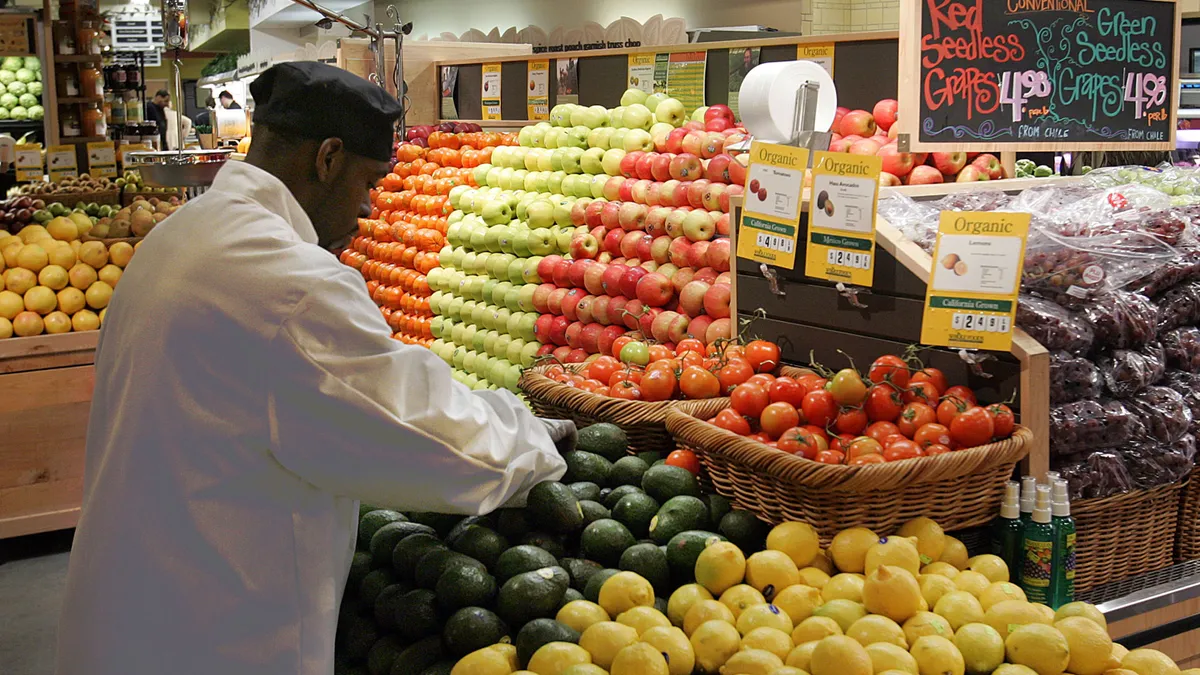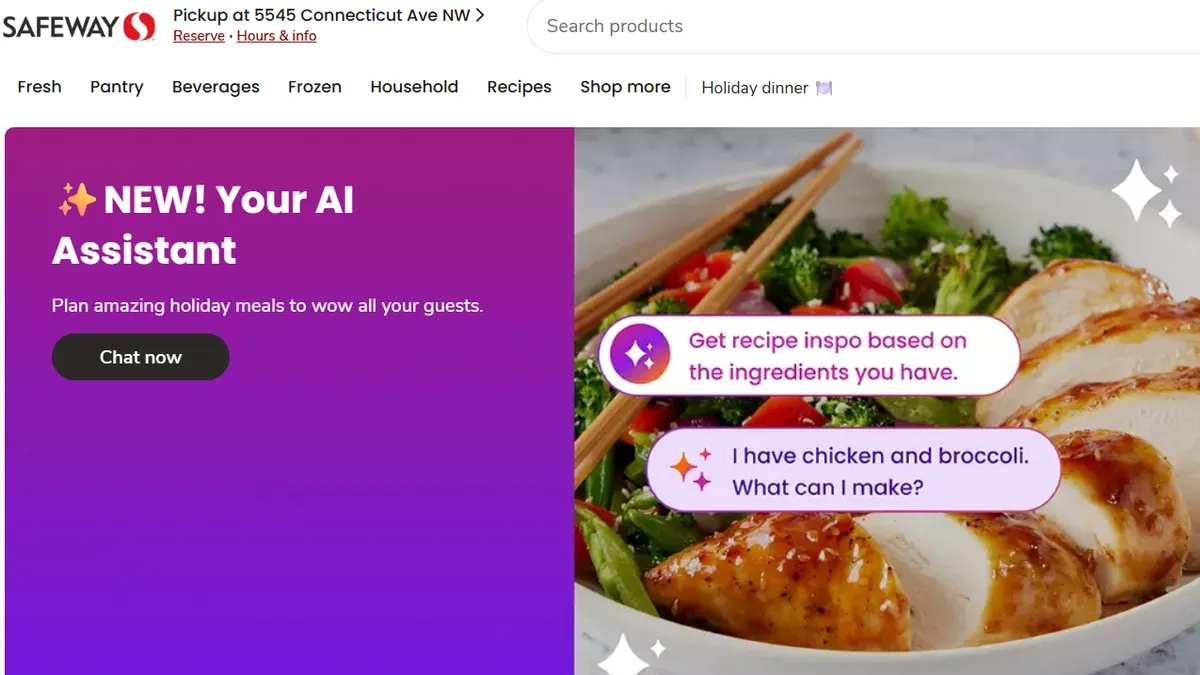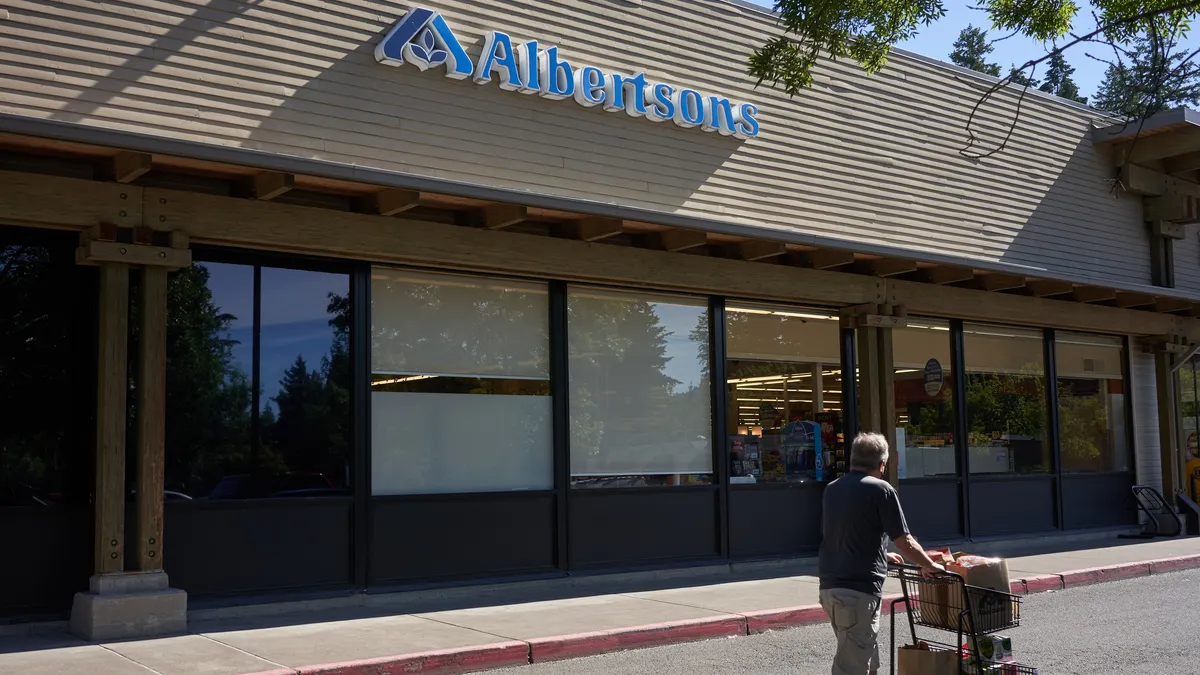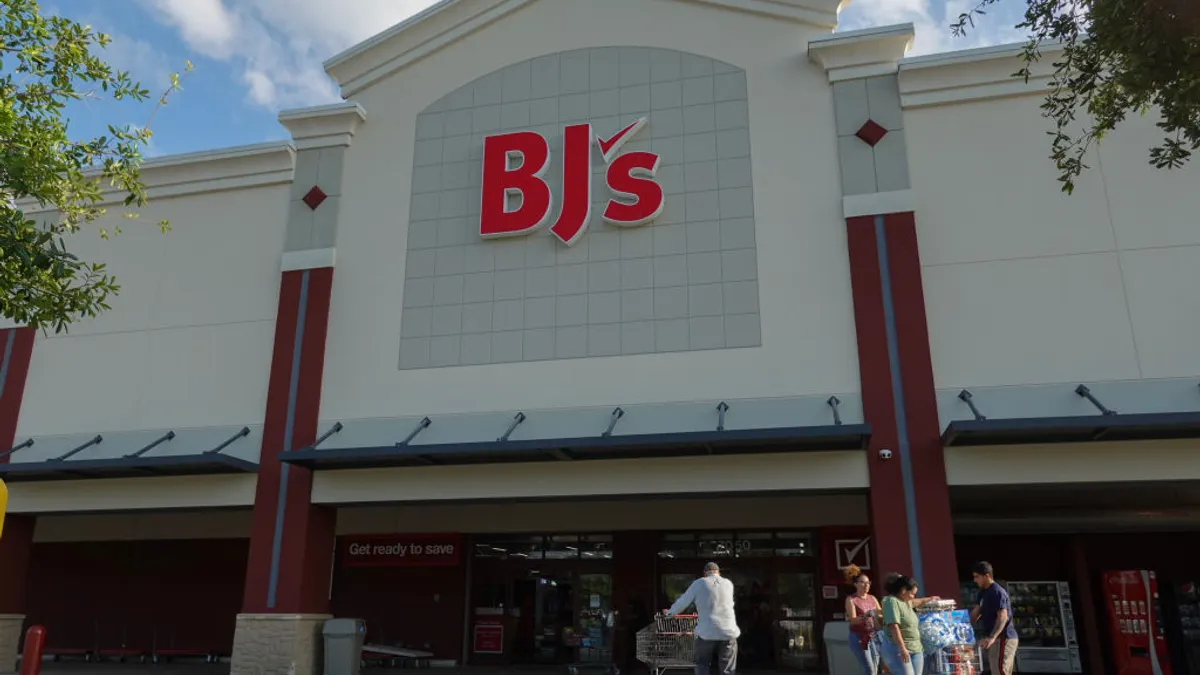Robots have swept across the grocery industry. They're checking shelf stocks at Schnucks stores, scrubbing floors at Walmart Supercenters and moving pallets of products from one place to another in distribution sites across the country.
At points across the supply chain, automation is helping retailers chip away at operational costs in a notoriously low-margin industry. But the technology's greatest challenge arguably lies ahead: Pushing American shoppers to buy more of their cereal, fruit, milk and bread online.
It's a challenge that all of the country's major grocers have taken on in one form or another. Kroger, in partnership with British e-grocer Ocado, plans to build massive automated warehouses across the country, while other chains like Ahold Delhaize and Albertsons are preparing to test pint-sized fulfillment centers attached to their stores.
By using robots to pick and pack online orders, and by probing new frontiers such as driverless delivery, supermarket chains are betting the lower prices and faster fulfillment that result will accelerate demand for online shopping and create meaningful opportunities to take market share from their competitors.
But in an industry where most consumers have a hard time getting excited about buying packaged groceries, much less prepared meals and produce online, will hordes of pricey robots really help turn the tide? And if so, who benefits and who doesn't?
The robot army
To watch an Ocado warehouse in action is to understand why automated fulfillment is so appealing to retailers right now.
Across a massive hive-like storage grid the size of three football fields, an army of box-like robots zip along, stopping frequently to retrieve boxes of cookies, bottles of shampoo and cans of soup from the square notches where they reside. The robots, which pass within five millimeters of one another, quickly snag all the items needed to assemble online orders, then deliver them to a human worker for final assembly.
The same process also is happening on a much smaller scale. In an otherwise unassuming space the size of a convenience store in Tel Aviv, Israel, small blue-and-gray robots operated by CommonSense Robotics scoot beneath multilevel structures that resemble large filing cabinets.
The robots receive cases of products as they come in from the loading dock and take them to the vertical shelving unit, which automatically stores items by type and temperature zone. As online orders come in from shoppers, the process is reversed. The vertical storage units pull down products and hand them off to the robots, which ferry them to a "touch point" where two workers unpack the cases and put the individual items into orders.
According to Ran Peled, CommonSense's head of marketing, robots control 99% of product movement within the facility and 95% of the overall work. Human workers, he said, are responsible for the finer points of fulfillment.
"If you're in the grocery business you still want to keep that human touch," Peled told Grocery Dive. "We're not talking about iPhones."
Both models represent a stark departure from the store-focused, pick-by-hand method most grocers employ to fill online orders. By automating this labor, and by doing so inside facilities dedicated to online fulfillment, grocers and technology firms aim to reduce costs and then pass those savings along to customers, helping stoke demand. Or so the thinking goes.
“Until [grocers] attack the work they’ve taken on and make it more efficient, they’re going to struggle with profitability,” Bill Bishop, chief architect of consulting firm Brick Meets Click, recently told Grocery Dive.
Kroger's odyssey
The company that has made the biggest bet so far on automated fulfillment is Kroger, with its first automated warehouse costing an estimated $55 million to build, and 20 more locations following that at strategic points across the country.
In addition to getting a fulfillment boost around its stores, Kroger executives have said Ocado’s warehouses could help the retailer reach consumers in regions where it doesn't have locations. This pure-play model, fueled by Ocado's ruthless efficiency, has been profitable in England and could become a major revenue stream for the nation's biggest supermarket chain.
"If you're in the grocery business you still want to keep that human touch. We're not talking about iPhones."

Ran Peled
Head of marketing, CommonSense Robotics
But this is a risky bet given the competition. In the northeast, the one major region of the country where Kroger doesn't have any stores, FreshDirect and Peapod have a strong foothold while Amazon is scaling its delivery through Whole Foods stores.
Ocado promises to deliver on price, speed and experience. But time is not on the company's side. It takes two to three years to build each automated warehouse — the first of which will be in Monroe, Ohio, with three other locations to be named by the end of this year, according to reports. That means that in the time it takes to get those first facilities up and running, competitors will have evolved their own technology and secured more customers.
Neil Saunders, managing director with GlobalData Retail, said it's hard to tell at this point how Kroger will build incremental sales with Ocado's technology and not just cannibalize store sales.
"The trick with this really is how is Kroger going to use this to drive sales?" he told Grocery Dive. "It's clear how they're going to use it to drive cost, but to drive the top line, it's still not clear how they intend to do that in a financially successful way."
It's also uncertain how Ocado's warehouses will interface with Kroger stores and customers. Kroger has said the warehouses can supply orders for store pickup, which would address stock levels but at the same time raise questions about efficiency as this would add another logistical step to the process. Also, because its fulfillment sheds are so massive, Ocado has to locate outside of population centers, potentially making on-demand orders difficult to fulfill.
For decades, grocers have sourced products from large distribution centers located in rural and suburban areas. The model works for store fulfillment but it creates challenges in meeting e-commerce demands, said Narayan Iyengar, senior vice president of digital and e-commerce with Albertsons.
"The problem with that is you're not close to your customers," he told Grocery Dive. "The delivery time and cost make it very prohibitive."
'We expect big things'
Getting closer to the customer is why Albertsons decided to pilot a 10,000-square-foot micro-fulfillment center at one of its stores. The location, which Iyengar declined to name, will open early next year in partnership with Takeoff Technologies. It will serve the store adjacent to it as well as several others.
With the so-called micro-fulfillment centers that Takeoff, CommonSense Robotics and other tech firms are building, grocers are looking to a technology that experts say is scalable, less costly, faster to build and can set up in very dense urban markets. In an interview with Grocery Dive, Takeoff co-founders Jose Aguerrevere and Max Pedro said its micro-fulfillment centers combine the proximity and convenience of the store with the efficiency of automated warehouse technology.
"Ocado takes two years to open a facility, but we do it in three months," said Pedro. "We can deploy very quickly because we’re using the underutilized space in the supermarket."
In addition to its deal with Albertsons, Takeoff is building a fulfillment center at a Stop & Shop store in Windsor, Connecticut that's set to open early next year. It comes as part of a broader revamp for the chain in the northeast. In October, Takeoff opened its first fulfillment center at a Sedano's in Miami. The location, which uses artificial intelligence-powered robots to pick and pack up to 60 items in just a few minutes, fills orders for 14 Sedano's outlets.
CommonSense Robotics says it will partner with five leading U.S. grocers in 2019 and 2020 to build automated micro-fulfillment centers that will prepare online orders for delivery in less than an hour, the company told Grocery Dive.
The biggest endorsement of micro-fulfillment's potential may be the fact that Walmart is doing it. In October, the retail giant announced that a supercenter in Salem, New Hampshire, would begin filling online orders through an adjacent 20,000-square-foot automated warehouse. The facility, designed by Alert Innovation and featuring a robot specially designed for Walmart, will carry and pick most of the store's assortment, though employees will still select produce and fresh items.
"Although this is a small pilot, we expect big things from it," Mark Ibbotsen executive vice president of central operations for Walmart, wrote in a blog post.
Swaying consumers
Like automated warehouses, driverless delivery also saves on labor costs and boosts efficiency. Kroger and Walmart are currently running tests in Arizona, while startup Udelv has linked up with various operators, including Buy For Less in Oklahoma City and Farmstead in San Francisco.
But regulations, which vary by state, could make expansion of driverless delivery difficult, while consumer sentiment remains cautious following two fatal crashes involving self-driving cars earlier this year. The number of consumers who believe highways would be safer with autonomous vehicles on the road dropped 18% over the past two years, according to the latest version of an annual survey by consulting firm Cox Automotive.
Early delivery vehicles are also slow-moving — the Nuro robot that delivers Kroger orders travels just 25 miles per hour — and in early tests, consumers have reportedly expressed frustration at having to walk out to the curb to collect their groceries rather than having someone bring the order to their door.
"Until [grocers] attack the work they've taken on and make it more efficient, they're going to struggle with profitability."

Bill Bishop
Chief architect, Brick Meets Click
Autonomous vehicle technology still has a long way to evolve, and experts are convinced the kinks will eventually get worked out. Professional services firm KPMG estimated driverless delivery vehicles could log as many as 78 million miles a year by 2040. Still, early headaches raise the question of whom driverless delivery benefits more, the retailer or the shopper?
"Focusing on delivery is sensible; it's low-speed, less complex, short distances, and there's no stopping the trend of more and more deliveries," Michael Ramsey, research director at Gartner, told the San Francisco Chronicle. "But existing delivery services that use humans can bring the thing to your door."
It's also easy to imagine automated online order fulfillment sweeping across the U.S. But for now at least, the technology is only feasible in very population-dense areas. CommonSense Robotics' micro-fulfillment centers could only work in the top 50 U.S. markets, Peled said. Outside of that, the company would struggle to get the order volume it needs to be profitable.
Automated fulfillment also assumes that consumers will love the improved service and having prices on par with in-store shopping, and therefore demand will accelerate at a rapid clip. But grocery so far has proven slow to embrace e-commerce, with research firms estimating just 2% to 3% of grocery sales currently happening online. Part of that is due to consumer loyalty to the in-store experience. Indeed, even as grocers are rolling out more online offerings, they’re remodeling their stores, improving their customer service and rolling out new services aimed at making shopping trips more enjoyable.
E-commerce demand has grown considerably during the past few years and will continue to grow, experts say. But will pricey technology upgrades like automated fulfillment boost demand enough to justify their hefty price tag?
"Every dollar that shifts from the store to online and from traditional retail model to automated model reduces the profitability of the store," Bishop said.
Will anyone make money?
As efficient as automated fulfillment promises to be, it’s still an added cost for labor traditionally performed by the customer. And, as Bishop noted, getting shoppers to buy their groceries online doesn't guarantee they’ll buy more — it just means they’ve switched channels. To make money, he said, new technology has to bring in new customers and get them to buy more groceries within a retailer’s omnichannel ecosystem.
It's not clear if and how automation will help reel in more shoppers and bigger orders for the grocers that provide it. What is clear, experts say, is that any benefits will flow to the chains that can scale and innovate with automation. This favors the Amazons and the Walmarts of the industry and puts even more pressure on small-scale operators.
A recent report from Deutsche Bank predicts Amazon will claim dominance in e-grocery, with 19% market share predicted by 2025 (up from a current 13%) compared to Walmart’s estimated 17% (up from 11%). The firm sees Instacart claiming a 19% share by 2025 while Kroger and Target are predicted to be at 7% and 2%, respectively.
Companies will continue to chase efficiency. The next evolution for automation, according to Bishop, is to merge the store and online fulfillment models into one stream. Running two separate models, he said, means that generally speaking one can only succeed by taking from the other.
This could work to benefit Kroger. Bishop said he could see the grocer eventually using Ocado’s warehouses to supply both its stores and its online orders
"If you can serve multiple needs with the same set of assets, you significantly raised the asset efficiency and turnover and profit of the business."
Albertsons' Iyengar believes that for now, automated fulfillment will work best on a case-by-case basis. In some crowded markets where demand and competition are high, it might make sense, while in others, he said, the traditional store-pick model will be the most efficient. Albertsons has rolled out its own e-commerce fulfillment services while also offering Instacart delivery from stores nationwide.
Rather than prioritize one option or another, Iyengar said he's focused on having the right tools to meet the demands of various markets, and to meet a wide range of consumer preferences.
"Shoppers are agnostic about how you get their groceries to them," he said. "They just want products delivered on time, at a fair price."

















